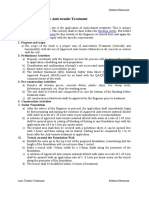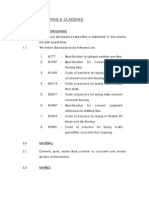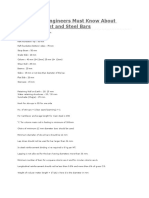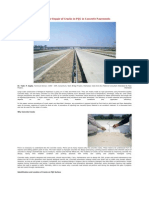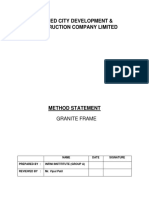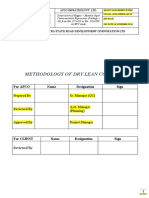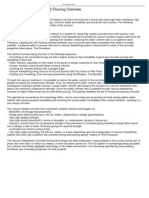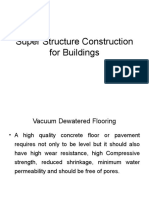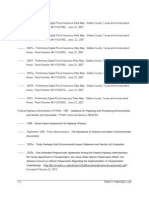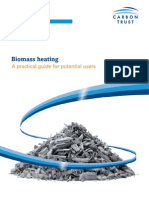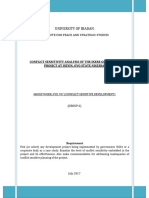0%(1)0% found this document useful (1 vote)
399 viewsVDF Flooring - Slideshare
VDF Flooring - Slideshare
Uploaded by
Ashik Rehmath ParambilVacuum Dewatered Flooring (VDF) is a concrete flooring method that uses vacuum dewatering to remove excess water from freshly laid concrete. This reduces the water-cement ratio, improving strength and durability while allowing easier finishing. The process involves laying concrete with high slump, vibrating, leveling, then using a vacuum pump and mat to extract water. The resulting floor is monolithic, shrinkage-free, and can be laid quickly at a rate of 100-200 square meters per day.
Copyright:
© All Rights Reserved
Available Formats
Download as PDF, TXT or read online from Scribd
VDF Flooring - Slideshare
VDF Flooring - Slideshare
Uploaded by
Ashik Rehmath Parambil0%(1)0% found this document useful (1 vote)
399 views6 pagesVacuum Dewatered Flooring (VDF) is a concrete flooring method that uses vacuum dewatering to remove excess water from freshly laid concrete. This reduces the water-cement ratio, improving strength and durability while allowing easier finishing. The process involves laying concrete with high slump, vibrating, leveling, then using a vacuum pump and mat to extract water. The resulting floor is monolithic, shrinkage-free, and can be laid quickly at a rate of 100-200 square meters per day.
Original Description:
Basic understanding of the Vaccum Dewatered Flooring technique.
Original Title
VDF Flooring- Slideshare
Copyright
© © All Rights Reserved
Available Formats
PDF, TXT or read online from Scribd
Share this document
Did you find this document useful?
Is this content inappropriate?
Vacuum Dewatered Flooring (VDF) is a concrete flooring method that uses vacuum dewatering to remove excess water from freshly laid concrete. This reduces the water-cement ratio, improving strength and durability while allowing easier finishing. The process involves laying concrete with high slump, vibrating, leveling, then using a vacuum pump and mat to extract water. The resulting floor is monolithic, shrinkage-free, and can be laid quickly at a rate of 100-200 square meters per day.
Copyright:
© All Rights Reserved
Available Formats
Download as PDF, TXT or read online from Scribd
Download as pdf or txt
0%(1)0% found this document useful (1 vote)
399 views6 pagesVDF Flooring - Slideshare
VDF Flooring - Slideshare
Uploaded by
Ashik Rehmath ParambilVacuum Dewatered Flooring (VDF) is a concrete flooring method that uses vacuum dewatering to remove excess water from freshly laid concrete. This reduces the water-cement ratio, improving strength and durability while allowing easier finishing. The process involves laying concrete with high slump, vibrating, leveling, then using a vacuum pump and mat to extract water. The resulting floor is monolithic, shrinkage-free, and can be laid quickly at a rate of 100-200 square meters per day.
Copyright:
© All Rights Reserved
Available Formats
Download as PDF, TXT or read online from Scribd
Download as pdf or txt
You are on page 1of 6
EPA Infrastructure Pvt. Ltd.
Vacuum Dewatered Flooring (VDF)
B-267, North Ex Mall
Sector-9, Rohini,
Delhi-110085
Email: info@epa-infrastructure.com
What is VDF?
The Vacuum Dewatered (VD)
Flooring method, is a system for
laying high quality concrete floors
with superior cost-effectiveness.
The key to the use of this method is
the dewatering of concrete by
vacuum process. Surplus water
from the concrete is removed
immediately after placing and
vibration, reducing the water-
cement ratio to an optimum level.
Why is VDF preferred?
Other Facts about VDF are as follows:
Adopting the VD flooring method facilitates use of concrete with better
workability than what is normally possible.
A lowered water to cement ratio due to vacuum dewatering leads to
improvement in each of the properties of concrete like wear resistance,
compressive strength, less shrinkage and minimum water permeability.
Through the vacuum treatment, it is possible to reduce the water
content in the concrete by 15-25% which greatly increases the
compressive strength.
By lowering the water-cement ratio, the tendency of shrinkage and
subsequent cracking is greatly reduced.
Since the water-cement ratio is lowered through vacuum dewatering,
concrete of high initial slump can be used while pouring.
Laying Method
The method involves the laying of
concrete in the following sequence:
Concrete in the conventional way but
with a higher slump so that the
workability is good and concrete
pouring and spreading is done fast.
Poker Vibration (specially on both
sides of the panel) is always essential
for floor thickness of 100mm and
above.
Surface Vibration using Double
Beams Surface Vibrator
Leveling the vibrated surface with a
straight edge.
Vacuum Dewatering using Vacuum
Pump and Suction Mat Top Cover &
Filter Pads.
Floating and Troweling of the
concrete pavement using Skimfloaters.
Advantages
The vacuum treated concrete floor/pavement, exhibits inherent advantages
viz.
Monolithic, Shrinkage free pavements.
Single panel without joints upto 100 sq. meters (depending on design
specifications)
Very high splitting strength.
Very high quality pavements in terms of strength of the pavement is
increased giving flexibility to adopt wither leaner mix or design a slab of
lesser thickness giving the required strength.
Controlled and uniform surface finish.
Very high output exceeding 100 to 200 sq. meters. in a day (depending
on the configuration of Vacuum Dewatering System and other site
conditions like concrete mixing and pouring speed).
Advantages
The vacuum treated concrete floor/pavement, exhibits inherent advantages
viz.
Monolithic, Shrinkage free pavements.
Single panel without joints upto 100 sq. meters (depending on design
specifications)
Very high splitting strength.
Very high quality pavements in terms of strength of the pavement is
increased giving flexibility to adopt wither leaner mix or design a slab of
lesser thickness giving the required strength.
Controlled and uniform surface finish.
Very high output exceeding 100 to 200 sq. meters. in a day (depending
on the configuration of Vacuum Dewatering System and other site
conditions like concrete mixing and pouring speed).
You might also like
- Technical Training Daikin Altherma Hybrid Heat Pump - Technical Training - EnglishDocument121 pagesTechnical Training Daikin Altherma Hybrid Heat Pump - Technical Training - Englishjmdc100% (1)
- Method Statement For Anti-Termite TreatmentDocument4 pagesMethod Statement For Anti-Termite TreatmentPEng. Tech. Alvince KoreroNo ratings yet
- Cover Block Method StaDocument1 pageCover Block Method StaRavi kumarNo ratings yet
- Honeycombing in Concreting: Causes & Measures: Shuttering Gaps Not Filled ProperlyDocument4 pagesHoneycombing in Concreting: Causes & Measures: Shuttering Gaps Not Filled ProperlytejakandulaNo ratings yet
- Methodology For ATT WorksDocument4 pagesMethodology For ATT Worksbeshnu garanaikNo ratings yet
- QA Checklist For Subsoil PipesDocument1 pageQA Checklist For Subsoil PipesRaman IyerNo ratings yet
- Test of RebarDocument10 pagesTest of RebarPrayas Subedi100% (1)
- Vacuum Dewatering FlooringDocument4 pagesVacuum Dewatering FlooringArunava Das100% (1)
- 01 - ValvesDocument25 pages01 - ValvesMahmoud Ahmed Ali Abdelrazik100% (1)
- Final TOR For Biogas PlantsDocument2 pagesFinal TOR For Biogas PlantsImran Khan NiaziNo ratings yet
- VDF FlooringDocument4 pagesVDF FlooringGOKULACHANDRU SNo ratings yet
- BlockworkDocument5 pagesBlockworkVikram DhabaleNo ratings yet
- Sunken Filling ChecklistDocument1 pageSunken Filling ChecklistASHOKKUMARNo ratings yet
- Is 777 For Glazed TilesDocument15 pagesIs 777 For Glazed TilesMadhu BabuNo ratings yet
- 3495 Part 1 Bricks PDFDocument10 pages3495 Part 1 Bricks PDFVb SeriesNo ratings yet
- Manjeera Construction LTD.: ReinforcementDocument5 pagesManjeera Construction LTD.: ReinforcementCivil Site 17100% (1)
- Tiles Laying AgreementDocument1 pageTiles Laying AgreementmgrvprasadNo ratings yet
- Slump Test: Sourse /location:: CC Pavement Grade of Concrete:: M30 Water Cement Ratio:: 0.45Document37 pagesSlump Test: Sourse /location:: CC Pavement Grade of Concrete:: M30 Water Cement Ratio:: 0.45ChManikumarNo ratings yet
- Cement Reconciliation ExampleDocument4 pagesCement Reconciliation ExampleDevenderNo ratings yet
- DSR PuneDocument5 pagesDSR PunedigvijayjagatapNo ratings yet
- Plaster Masonry TolerancesDocument8 pagesPlaster Masonry TolerancesGhayas JawedNo ratings yet
- Plastering: Indian Standard (BIS Codes) Specifications UsedDocument4 pagesPlastering: Indian Standard (BIS Codes) Specifications UsedMĄnjů Đ ĞNo ratings yet
- 030 - CHECKLIST FOR Enamel PainitngDocument1 page030 - CHECKLIST FOR Enamel PainitngR Harshavardhana100% (1)
- MTC For ThermocolDocument2 pagesMTC For ThermocolhariprasadNo ratings yet
- 7.Ms-External Plaster WorkDocument6 pages7.Ms-External Plaster WorkShenbagaraja PandianNo ratings yet
- Things Site Engineers Must Know About Reinforcement and Steel BarsDocument4 pagesThings Site Engineers Must Know About Reinforcement and Steel BarsMohammad Irshad AlamNo ratings yet
- Test Limits & FrequencyDocument9 pagesTest Limits & FrequencySangram MundeNo ratings yet
- Amendment N - I MA Y 2002 IS 1200 (PART 8) : 1993 Methods Measurement of Building and Civil Engineering WorksDocument8 pagesAmendment N - I MA Y 2002 IS 1200 (PART 8) : 1993 Methods Measurement of Building and Civil Engineering Worksraviteja036No ratings yet
- Specs 2019 V2Document756 pagesSpecs 2019 V2jaipalNo ratings yet
- Role of SMF Admixture in ConcretDocument23 pagesRole of SMF Admixture in ConcretRamkishor SahuNo ratings yet
- Methodology-TG DECK-rev0 (4feb12)Document11 pagesMethodology-TG DECK-rev0 (4feb12)beshnu garanaik100% (1)
- Pressure GroutingDocument1 pagePressure GroutingKiran Kumar JhaNo ratings yet
- PQC Cracks Repair MethodsDocument5 pagesPQC Cracks Repair MethodsBattinapati Lakshmana RaoNo ratings yet
- Material Testing ManualDocument33 pagesMaterial Testing Manualpriths_007No ratings yet
- 04 Method Statement For Block WorkDocument7 pages04 Method Statement For Block WorkbalaNo ratings yet
- Auramix 200: High Performance PCE Based Admixture For Wide Range of Concrete GradesDocument2 pagesAuramix 200: High Performance PCE Based Admixture For Wide Range of Concrete GradesBijaya RaulaNo ratings yet
- NP4 Pipe Installation and Backfill - MethodologyDocument4 pagesNP4 Pipe Installation and Backfill - MethodologyRabnawaz Imam100% (1)
- Work Method Statement For Plumbing and Sanitary WorksdocxDocument12 pagesWork Method Statement For Plumbing and Sanitary Worksdocxgvs raoNo ratings yet
- Method Statement For Granite FrameDocument7 pagesMethod Statement For Granite FrameMonali Varpe100% (1)
- False Celling Check ListDocument2 pagesFalse Celling Check Listjohn paul100% (1)
- Accessories ListDocument10 pagesAccessories ListShashank Hegde100% (1)
- Methodology Brick Bat CobaDocument1 pageMethodology Brick Bat Cobabala subramanyam100% (2)
- Procedure For Slab To SlabDocument5 pagesProcedure For Slab To SlabKarthik Chalageri 7100% (1)
- TDS Conbextra EP10M IndiaDocument2 pagesTDS Conbextra EP10M Indiasyed AffanNo ratings yet
- DLC Methodology - Nagpur MumbaiDocument13 pagesDLC Methodology - Nagpur MumbaiGanesh Kumar TulabandulaNo ratings yet
- Granite & Marble WorksDocument11 pagesGranite & Marble WorksQAQC Nandanam100% (1)
- Checklist For VDFDocument1 pageChecklist For VDFGabriel Gabe100% (1)
- Authorisation For Layig GSB and WMM-Rev-R2Document1 pageAuthorisation For Layig GSB and WMM-Rev-R2Guna SekaranNo ratings yet
- Form Work, Reinforcement & Concreting - MethodologyDocument10 pagesForm Work, Reinforcement & Concreting - MethodologyRabnawaz Imam100% (1)
- Road Embankment ITPDocument6 pagesRoad Embankment ITPMahendraSinghNo ratings yet
- HKKJRH Ekud HKKJRH Ekud HKKJRH Ekud HKKJRH Ekud HKKJRH EkudDocument16 pagesHKKJRH Ekud HKKJRH Ekud HKKJRH Ekud HKKJRH Ekud HKKJRH EkudOMEGA CONSULTANT SERVICESNo ratings yet
- Deck Slab MethodologyDocument8 pagesDeck Slab Methodologyrks.nh119d50% (2)
- Checklist For Plaster PreparationDocument1 pageChecklist For Plaster PreparationMani AppaNo ratings yet
- 2.Ms Excavation Back FillingDocument9 pages2.Ms Excavation Back FillingShenbagaraja PandianNo ratings yet
- cOVER BLOCKSDocument4 pagescOVER BLOCKSPrashant Mankar100% (1)
- Method Statement For Exterrnal PlasteringDocument7 pagesMethod Statement For Exterrnal PlasteringSagar ParabNo ratings yet
- Method Statement Marble Fixing - Quality and ConstructionDocument13 pagesMethod Statement Marble Fixing - Quality and Constructionumit100% (1)
- 4.Ms Masonry WorkDocument13 pages4.Ms Masonry WorkShenbagaraja PandianNo ratings yet
- JSW Ggbs 1 2015 PDFDocument1 pageJSW Ggbs 1 2015 PDFMohammed Javeed ahmedNo ratings yet
- Checklist For Marble Dry Cladding WorkDocument1 pageChecklist For Marble Dry Cladding WorkGabriel Gabe100% (1)
- Index 2Document1 pageIndex 2dandekarvaibhavNo ratings yet
- Super Structure Construction For BuildingsDocument12 pagesSuper Structure Construction For BuildingsHari KumarNo ratings yet
- Vacuum Dewaterimg: New Way For Concrete Flooring by Tremix MethodDocument7 pagesVacuum Dewaterimg: New Way For Concrete Flooring by Tremix Methodsachinkarape4844No ratings yet
- Ally 20DFDocument6 pagesAlly 20DFGUDANG BIENo ratings yet
- Osd 1Document4 pagesOsd 1Wan Mahiram100% (1)
- 06 BSM TG Influent ModelDocument10 pages06 BSM TG Influent ModelBilly CheungNo ratings yet
- Gate Valves in IndustryDocument3 pagesGate Valves in IndustryKogulan SubramaniamNo ratings yet
- Valve Types and SymbolsDocument164 pagesValve Types and Symbolssantos ayala100% (4)
- Drip Irrigation System YashDocument11 pagesDrip Irrigation System Yashyashbansal4445No ratings yet
- Global WarmingDocument45 pagesGlobal WarmingSidak AroraNo ratings yet
- Ls S Trinity Parkway March 2012 Part 4Document290 pagesLs S Trinity Parkway March 2012 Part 4Michael LindenbergerNo ratings yet
- 5999-Texto Do Artigo-29539-1-10-20110221Document7 pages5999-Texto Do Artigo-29539-1-10-20110221Leonildo DerganNo ratings yet
- Standards FOR Landscape Irrigation Systems: January 2008 EditionDocument27 pagesStandards FOR Landscape Irrigation Systems: January 2008 EditionIbrahim SirpiNo ratings yet
- MRP Catalog - North - July 2022Document96 pagesMRP Catalog - North - July 2022amjadNo ratings yet
- 3% AFFF C-303 Espuma Hidrocarburos PDFDocument4 pages3% AFFF C-303 Espuma Hidrocarburos PDFNery MartinezNo ratings yet
- Melody Baglione: Building Sustainability Into Control Systems Handling UnitsDocument12 pagesMelody Baglione: Building Sustainability Into Control Systems Handling UnitsErmiasNo ratings yet
- Center Pivot Irrigation Design PDFDocument57 pagesCenter Pivot Irrigation Design PDFfrcarras11100% (1)
- 5A-Solid Bulk CargoDocument18 pages5A-Solid Bulk CargoKhairudyIzwan100% (2)
- Geomembrane Liners in Wastewater Treatment Ponds Whales and Their PreventionDocument5 pagesGeomembrane Liners in Wastewater Treatment Ponds Whales and Their PreventionDimas NugrahaNo ratings yet
- MsdsDocument6 pagesMsdsTifanny WijayaNo ratings yet
- Biomass Heating A Practical Guide For Potential Users (CTG012)Document94 pagesBiomass Heating A Practical Guide For Potential Users (CTG012)Prashant VaraNo ratings yet
- 3 Gorges DamDocument2 pages3 Gorges DamAdeel AsgharNo ratings yet
- 1-Roughness Evaluation ShotcreteDocument18 pages1-Roughness Evaluation ShotcreteAhsan MurtazaNo ratings yet
- FM1311 Centrifugal Fire Pumps Split-Case Type Axial orDocument1 pageFM1311 Centrifugal Fire Pumps Split-Case Type Axial ordeepaliadmuthe5158No ratings yet
- Oil Free Compressor en PDFDocument24 pagesOil Free Compressor en PDFKiatchai IttivikulNo ratings yet
- Hydro Power Plant Site Selection ParametersDocument25 pagesHydro Power Plant Site Selection ParametersAbdul RafayNo ratings yet
- Conflict Sensitivity Analysis of Ikere Gorge DamDocument14 pagesConflict Sensitivity Analysis of Ikere Gorge DamRalph NduulNo ratings yet
- 4-Nitroacetanilide (Prac 5grDocument7 pages4-Nitroacetanilide (Prac 5grDesi YusriantiNo ratings yet
- Environmental Protection and Management of Volos Sea-PortDocument97 pagesEnvironmental Protection and Management of Volos Sea-PortValerie Masita HariadiNo ratings yet
- February Newsletter - Project RISHIDocument2 pagesFebruary Newsletter - Project RISHIProjectRISHINo ratings yet

